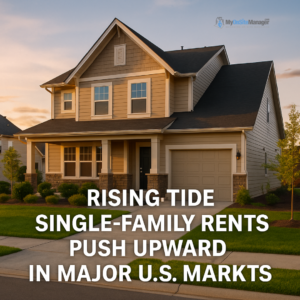
Across major U.S. metropolitan areas, single-family rental prices are climbing steadily. While the increase may not be dramatic month to month, this gradual rise signals a deeper, sustained shift in the housing landscape.
With mortgage rates still elevated and homeownership costs out of reach for many, more families and individuals are choosing to rent single-family homes instead of buying. This demand is especially concentrated in markets with strong job growth, affordable living compared to coastal hubs, and expanding suburban developments.
This trend reinforces what many industry analysts have been forecasting: the single-family rental (SFR) market isn’t just holding strong it’s becoming one of the most resilient segments of the real estate sector.
Why Single-Family Rents Are Rising
1. Affordability Pressure for Homebuyers
Despite some stabilization in the broader housing market, mortgage rates remain high. The monthly cost of purchasing a home including taxes and insurance has risen well beyond the comfort zone of many households. This gap between home affordability and income growth is pushing people toward renting as a more viable option.
2. Limited Supply of Rentals
Even as demand grows, the supply of available single-family rentals remains tight. Many existing homeowners are locked into historically low mortgage rates and are reluctant to sell, further restricting inventory. New construction has increased but hasn’t yet caught up with the surge in rental demand.
3. Strong Migration Patterns
Population shifts are also influencing rent growth. Cities in the Sun Belt and Midwest where affordability is still relatively better than coastal states are experiencing influxes of new residents. This increased competition among renters is allowing landlords to gradually push rents upward.
4. Institutional Expansion
Large investors and private equity firms are buying and developing SFR communities at scale, particularly in high-growth markets. These portfolio strategies are designed for steady rental income, and with stronger demand, they’re also exerting upward pressure on pricing.
Which Markets Are Seeing the Strongest Growth?
While rent growth is visible nationwide, not all metros are experiencing it equally.
-
High-growth metros in Texas, Florida, Arizona, and parts of the Midwest are leading the charge with above-average increases. These regions offer better affordability, expanding infrastructure, and employment opportunities, attracting both domestic migrants and investors.
-
Coastal cities, meanwhile, are seeing steadier, slower growth due to already elevated prices and regulatory pressures that limit sharp rent increases.
-
Suburban markets are increasingly popular, as many renters seek more space, privacy, and a “homeownership feel” without the financial burden of buying.
This geographic divergence is creating a two-speed market: one where some regions surge ahead, and others plateau or stabilize.
The Role of Institutional Investors in the SFR Space
The rise of institutional ownership in single-family rentals is one of the defining features of today’s housing market.
These investors are:
-
Acquiring large portfolios of homes in high-demand metros
-
Building “build-to-rent” communities with professional management and amenities
-
Leveraging technology to streamline operations, pricing, and tenant experience
While this can lead to greater consistency and supply in some markets, it can also intensify competition for buyers and renters alike especially when inventory is already tight.
For smaller landlords and individual investors, this means competing on service, location, and flexibility rather than scale.
Implications for Different Stakeholders
For Renters
-
Expect gradual but steady rent increases in many regions.
-
Suburbs and secondary markets may still offer better affordability than major urban cores.
-
Amenities, proximity to jobs, and lease flexibility will play a bigger role in decision-making.
-
Tenants should start budget planning earlier to stay ahead of renewal increases.
For Landlords & Property Investors
-
Rising demand creates opportunities to optimize pricing strategies.
-
Upgrading property features and professionalizing management can boost competitiveness, especially against large institutional players.
-
Investors may find the best yields in emerging growth metros, where rent growth outpaces operational costs.
For Policymakers & Developers
-
There’s a pressing need to increase supply, particularly of entry-level and rental housing.
-
Zoning reforms, permitting flexibility, and infrastructure investments can help balance the market.
-
Policymakers should keep a close eye on institutional consolidation to ensure healthy competition and tenant protections.
What’s Next for the SFR Market?
Industry experts predict that the single-family rental sector will remain strong well into 2026, particularly if mortgage rates stay elevated. Even a modest rent increase across high-demand regions can have a significant cumulative impact on affordability and investment returns.
Potential scenarios ahead:
-
Continued steady growth in rental rates as demand remains high
-
A widening gap between metros that build more housing and those that don’t
-
Increased competition between institutional landlords and small investors
-
Further migration toward suburbs and smaller cities, shaping a new rental geography
Key Takeaway
The steady climb in single-family rental rates reflects more than just short-term market fluctuations it’s a structural shift in how Americans live, rent, and invest. For many families, renting is no longer a temporary option but a long-term lifestyle choice, and investors are taking note.
The question isn’t just “Will rents rise?” anymore it’s “Who will adapt best to this changing landscape?”
Source: GlobeSt – Single-Family Rents Edge Higher as Growth Firms Across Major Markets
